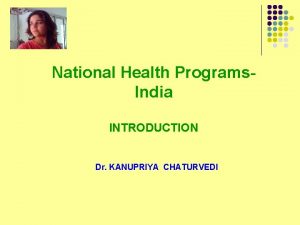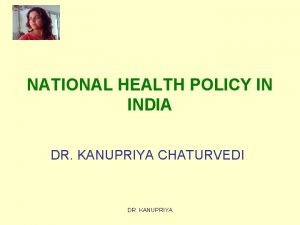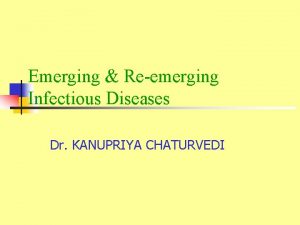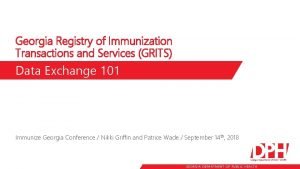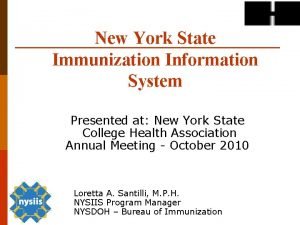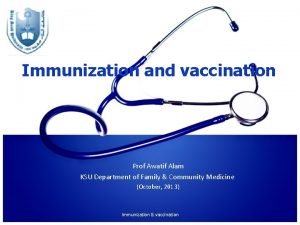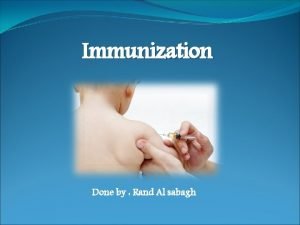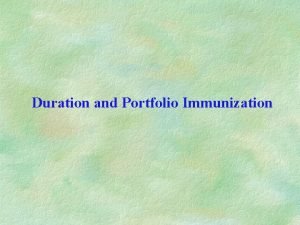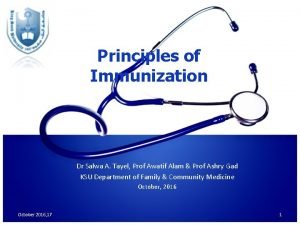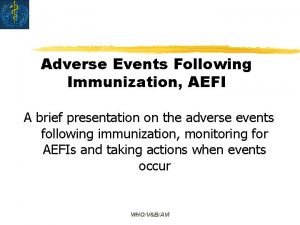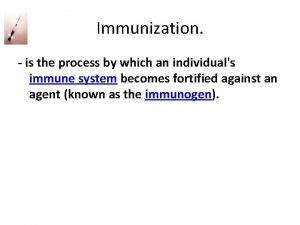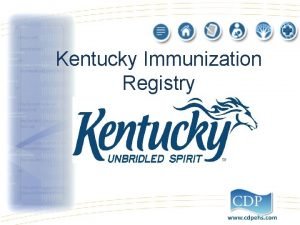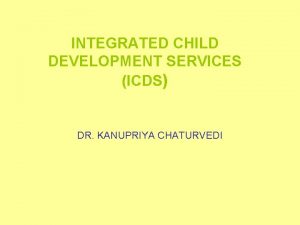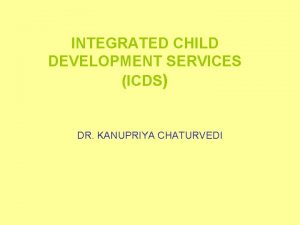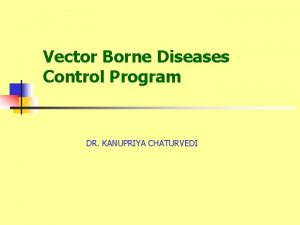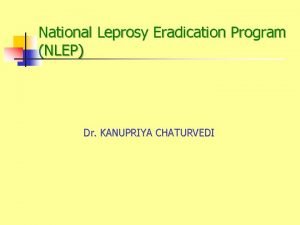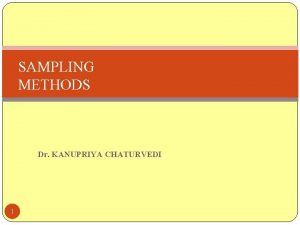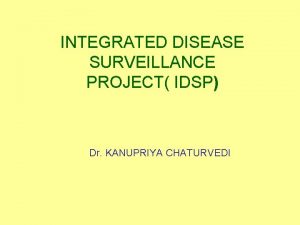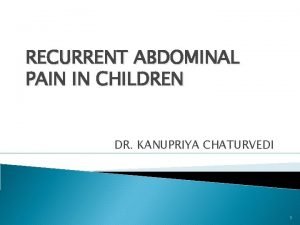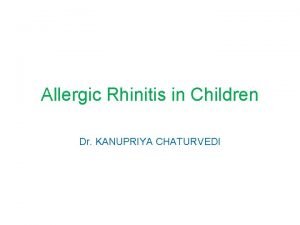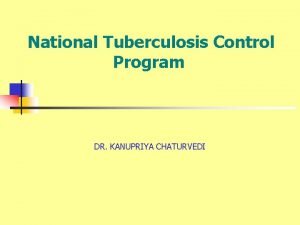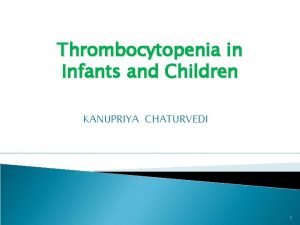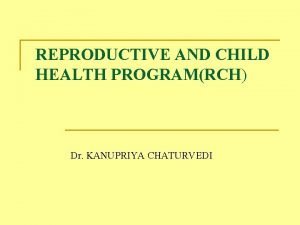Immunization Services DR KANUPRIYA CHATURVEDI DR S K




















- Slides: 20

Immunization Services DR. KANUPRIYA CHATURVEDI DR. S. K. CHATURVEDI

Objectives • Describe what comprises routine immunization services – Components – Activities within components – Role of a Plan of Action

What is “routine immunization” • No standard definition – Hard to define – Means different things to different people – Regional and agency differences • The sum of human and logistical activities/events to ensure the regular delivery & uptake of vaccines & the monitoring of their positive & adverse impact

What is “routine immunization” • Implies the “regular” delivery, i. e. , known schedule, of EPI vaccines – Fixed posts &/or outreach • Part of a larger plan • Not time limited • Goal to provide needed vaccines to all eligible persons and to successive birth cohorts

Routine services: Ensuring that all children receive the WHO recommended vaccination schedule Age EPI visit Vaccine Hepatitis B - options Option 1 Option 2 Option 3 Hep B Birth 0 BCG (OPV) 6 weeks 1 OPV 1, DTP 1, Hib 1 Hep B 1 OPV 2, DTP 2, Hib 2 Hep B 2 monovalent or in combo (monovalent) OPV 3, DTP 3, Hib 3 Hep B 3 monovalent or in combo (monovalent) 10 weeks 14 weeks 9 -12 months 2 3 4 Measles (Rubella) DTP-Hep B 1 monovalent or in combo DTP-Hep B 2 DTP-Hep B 3

WHO’s Approach: Components of routine immunization systems Vaccine Supply & Quality Logistics Service delivery Surveillance Advocacy & Communication

Components glued together by: • • • Planning Management Coordination Supervision Training Financing Components & “glue” exist at national, provincial, district & local level…. Cascading effect

Activities……………. . Vaccine Supply & National level. . Policy on Quality • Procurement • Quality • Local production • National Regulatory Authority • Strategies for international procurement • Timely vaccine ordering • Financial security for purchase • Supply planning (VVMs, vaccines, syringes) Lower Levels. . Ordering & supply planning. . Getting vaccine & supplies to the lower levels for administration

Activities……… National Level. Policy statement & implementation • Injection safety • Health care waste disposal • Cold chain • National central cold store • Vaccine/supply management • Transport management • Supplies, supervision • Lower levels • Vaccine/supply management • Cold chain • Transport • Getting the vaccine to the people Logistics

Activities……. Surveillance National level • Policy • Standards & guidelines • Case definitions • Disease, coverage, adverse events monitoring for nation • Data management systems • Improving data quality • Laboratory Services Local level • Disease, adverse events monitoring • Vaccine supply • Vaccination info management • Register • Tally sheets

Activities……. Surveillance Types of surveillance in EPI • Routine • Generally passive, provides idea on trends, impact of program • Special routine – AFP, fever/rash • Sentinel • Complements weak routine for key diseases • Early warning for outbreaks • Special Surveys • Set baseline disease burden

Activities……… National Level • Technical documents & guidelines • Capacity building • Partnerships with media • Social Mobilization Local Level • Partnerships with the community • Social Mobilization Advocacy & Communication

Activities………… National Level • Supporting local level Local level • Vaccination activities Service delivery

Activities………… Delivery modes - Fixed sites - Outreach - Mobile services - Pulse campaigns - Campaigns Service delivery Each mode has its own advantages & disadvantages, its own indications for use, $$ considerations No single mode is appropriate for all circumstances/diseases

The “glue” 5 key components of EPI 1. Planning 2. Management 3. Coordination 4. Supervision 5. Training 6. Financing Activities to get the job done National provincial district health facility

Monitoring Program Performance • Key indicators (an example) – Coverage levels • Fully vaccinated child, individual antigens – Access to services • BCG and/or DTP 1 coverage – Tracking & follow up activities • Dropout - DTP 1 to Measles • Median age of receipt of vaccines – Missed opportunities – Cold chain quality • Vaccines at correct temperature – Provider knowledge/practices

Plans of Action (POA) 5 key components of EPI 1. Planning 2. Management 3. Coordination 4. Supervision 5. Training POAs. . Detailed & costed activities to ensure adequate implementation of key components and the “glue” … 5 year & 1 year plan … National, provincial, district level plans Must be a living document used to monitor routine immunization services

Plans of Action • Different formats in different countries, regions • Should contain – For each component • • • Goals/objectives Key activities Timeline Cost Responsibility – For each type of glue • Key activities • Timeline • Cost

District Plans of Action • Important for efficient service delivery • Similar to national, but with emphasis on – – – High risk areas High risk populations Special activities, e. g. , outreach, mobile services Social promotion Supervision Local funding – sources and channels

Inter-agency Coordinating Committee (ICC) • Composition – Example: MOH, WHO, UNICEF, USAID, Rotary, NGOs, etc – Varies by country • Promotes collaboration & cooperation • Prevents – Duplication of activities – Ensures that all activities/components/”glue” are covered and will be addressed in the POA
 Dr. kanupriya chaturvedi
Dr. kanupriya chaturvedi National health policy 2002
National health policy 2002 Dr. kanupriya chaturvedi
Dr. kanupriya chaturvedi Kanupriya host death
Kanupriya host death Darshana chaturvedi
Darshana chaturvedi Jayanshu chaturvedi
Jayanshu chaturvedi Pravin chaturvedi
Pravin chaturvedi Dn chaturvedi reliance
Dn chaturvedi reliance Grits immunizations
Grits immunizations What is nysiis
What is nysiis 3alam 3awatif
3alam 3awatif Immunization schedule definition
Immunization schedule definition Duration of portfolio
Duration of portfolio Importance of immunization slideshare
Importance of immunization slideshare Aefi examples
Aefi examples Active immunization definition
Active immunization definition Vitamin a dose in immunization schedule
Vitamin a dose in immunization schedule Impatitis
Impatitis Immunization schedule
Immunization schedule Portfolio immunization example
Portfolio immunization example Kyir
Kyir
